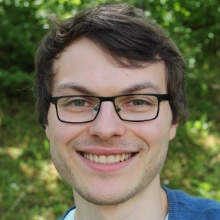Kilian Weishaupt, doctoral researcher at the Department of Hydromechanics and Modelling of Hydrosystems (LH2) and within the framework of SFB 1313 and the Integrated Research Training Group IRTG-IMPM, will defend his dissertation "Model Concepts for Coupling Free Flow with Porous Medium Flow at the Pore-Network Scale: From Single-Phase Flow to Compositional Non-Isothermal Two-Phase Flow".
Date: March 12, 2020
Time: 10 am
Venue: MML, U. 1.003, Pfaffenwaldring 61, 70569 Stuttgart
Abstract
Coupled systems of free flow adjacent to a porous-medium appear ubiquitously in nature and in technical applications. Examples for interface-driven transport and exchange processes include soil evaporation, fuel cell water management or food drying. Understanding the complexity of pore-scale mechanisms is paramount to build efficient and reliable mathematical and numerical models.
Typically, averaged models based on the concept of a representative elementary volume (REV) approach are chosen to overcome the enormous computational demand of solving these types of systems on the pore scale. This leads, however, to a loss of detail for certain sub-scale processes which might critically affect the global system behavior.
Model In this work, we propose a novel hybrid approach which combines models of different scales in order to increase the level of detail for the description of flow and transport processes at the interface between free flow and the porous medium at a comparatively low computational cost.
The central feature is a pore-network model representing the transition region between the porous matrix and the free flow. This model locally resolves pore-scale processes on a simplified yet equivalent porous geometry which makes it comparatively efficient.
We present and discuss coupling conditions to ensure thermodynamic consistency. Following a monolithic coupling approach, the fluxes of mass, momentum and energy across the domain interfaces are preserved implicitly while no coupling iterations are required. In order to resolve flow and transport processes beyond capillary equilibrium states, a fully implicit dynamic pore-network model is employed.
We present numerical results for models of different physical complexity, ranging from single-phase flow to non-isothermal compositional two-phase flow.


